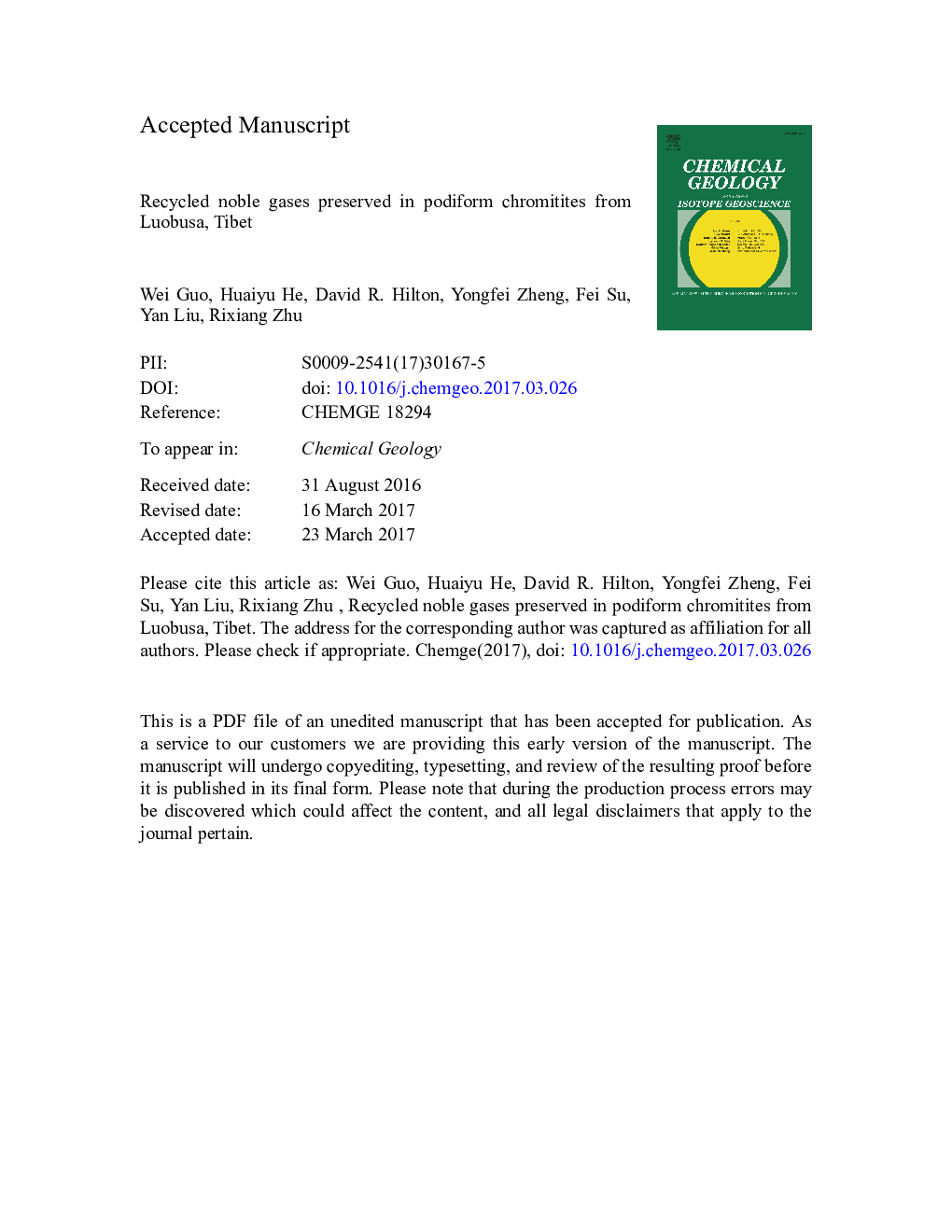| کد مقاله | کد نشریه | سال انتشار | مقاله انگلیسی | نسخه تمام متن |
|---|---|---|---|---|
| 5782659 | 1637505 | 2017 | 53 صفحه PDF | دانلود رایگان |
عنوان انگلیسی مقاله ISI
Recycled noble gases preserved in podiform chromitites from Luobusa, Tibet
دانلود مقاله + سفارش ترجمه
دانلود مقاله ISI انگلیسی
رایگان برای ایرانیان
کلمات کلیدی
موضوعات مرتبط
مهندسی و علوم پایه
علوم زمین و سیارات
ژئوشیمی و پترولوژی
پیش نمایش صفحه اول مقاله

چکیده انگلیسی
We report noble gas (He, Ne, Ar) signatures of chromite and olivine separates from the Luobusa chromitites in Tibet to better understand the volatile compositions trapped in the minerals, and further to trace the origin of melts responsible for formation of the chromite deposits. The studied samples can be divided into two groups based on petrography and distinct noble gas signatures. Group I samples are free of carbonates and have 3He/4He ratios from 0.81 to 2.36 Ra (where Ra is the 3He/4He ratio of air = 1.4 Ã 10â 6) and air-like Ne and Ar isotopic compositions irrespective of chromitite structure types. Most 3He/4He ratios of Group I samples are higher than air, suggesting apparent presence of mantle volatiles. Given the 4He/20Ne and 3He/36Ar several orders of magnitude higher than air, negligible contributions are from the atmospheric helium. The observed He isotope compositions thus can be regarded as a two-component mixture of mantle-derived and radiogenic He. A broadly positive correlation between 3He and 36Ar in nodular chromitite samples indicates a source mixing between mantle and recycled noble gases but not due to shallow air contamination. In addition, the wide distribution range of 20Ne/36Ar also supports a subduction-related origin of neon and argon. Combined with major element data, the most appropriate tectonic setting to generate such noble gas signatures in Group I samples is subduction zone (probably forearc) where favorable conditions are present for the formation of the chromitites. In contrast, Group II samples containing carbonates have much more radiogenic 3He/4He ratios of 0.03 to 0.3 Ra but much less radiogenic 40Ar/36Ar ratios of 344 to 420. In combination with the occurrence of carbonate veins it is suggested that Group II samples are predominated by supracrustal components that may be imparted during or after the emplacement stage. A comparison of these two group samples indicates that the primary noble gas signatures reflecting the characteristics of ore-forming melts can be preserved in chromite and olivine grains (Group I samples) and thus used to trace the origin of podiform chromitites.
ناشر
Database: Elsevier - ScienceDirect (ساینس دایرکت)
Journal: Chemical Geology - Volume 469, 10 October 2017, Pages 97-109
Journal: Chemical Geology - Volume 469, 10 October 2017, Pages 97-109
نویسندگان
Guo Wei, He Huaiyu, David R. Hilton, Zheng Yongfei, Su Fei, Liu Yan, Zhu Rixiang,